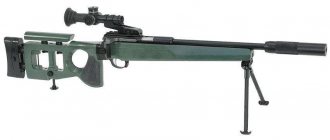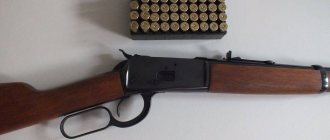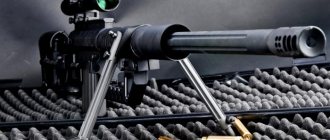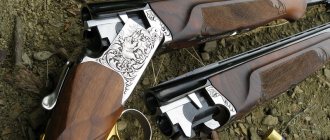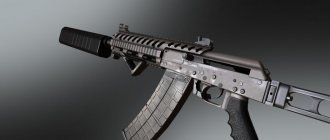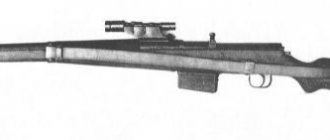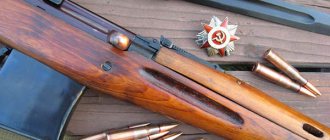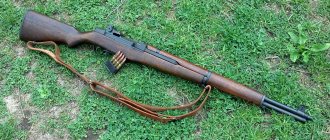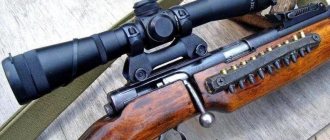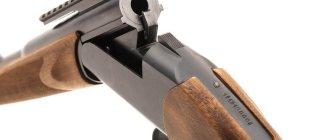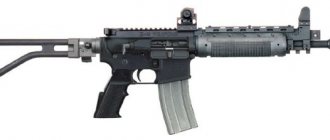The TOZ-99 hunting carbine of 5.6 mm caliber is a unique semi-automatic carbine produced by the Tula Arms Plant. This model has been produced since 1997 and is positioned as a further development of the popular small TOZ-78, which is still in production. The development of the carbine was not difficult, since more than 50% of the components of the TOZ-99 and TOZ-78 are unified with each other.
The main difference is the reloading system. The gun is traditionally manual, but the 99 model boasts automatic reloading. Since the TOZ-99 self-loading carbine is not very popular among Russian hunters, its export modification was soon released - the TOZ-99-04 rifle, which is traditionally distinguished by its build quality and the presence of threads on the muzzle of the barrel. This thread allows you to install various silencers on the carbine.
Like all small-caliber guns of the Tula Arms Plant, the TOZ-99 self-loading carbine is intended primarily for fishermen and recreational shooting. The use of automation based on the recoil of the free shutter made it possible to deal with the eternal problem of all classic “bolt guns” - insufficient rate of fire. Technical characteristics allow you to quickly “get” the animal without giving it the opportunity to hide.
TOP 10 best small-caliber rifles
Today we will look at the top 10 best small-caliber rifles in the world.
The first rifles to use the .22 Long Rifle
there was a Marlin 1891 with a Henry brace and a Winchester 1890 with a pump-action reloading system.
Thanks to their light weight, lack of recoil, quiet shot sound and budget ammunition, rimfire rifles are an excellent choice for beginners and recreational shooting enthusiasts.
So in 10th place is ArmaLite AR-7
. Developed in 1959 by American designer Eugene Stoner, the Armilite AR7 rifle is positioned as a weapon for tourists and travelers, as well as for initial shooting training. It was originally designed as a survival weapon for pilots. 22 gauge, .22 Long Rifle cartridge. The principle of operation is the recoil of a free shutter. Shooting is carried out from a closed bolt. Effective firing range 100 meters. The detachable magazine capacity is 8 rounds, but there are magazines for 10, 15 and 25 rounds. Weight 1.13 kg. The main reason for the popularity of the AR-7 among gun enthusiasts is its compactness, speed and ease of disassembly: just remove the magazine, unscrew the barrel, and remove the bolt box. All this, including two magazines, fits inside a plastic stock.
9th place goes to Browning Semi-Auto 22
. Designed by John Browning himself, this semi-automatic rifle has been in production from 1914 to the present day. The principle of operation is the recoil of a free shutter. 22 gauge, .22 Long Rifle cartridge. The window for ejecting cartridges and the bolt handle are located at the bottom of the receiver. There is no shutter stop. A tubular built-in magazine is placed inside the stock and is loaded through a special opening. Magazine capacity 11 rounds. Has a quick-release barrel. In a matter of seconds, the rifle is disassembled into 2 parts, which can be placed in any backpack or bag. Weight 2.3 kg. To date, more than 500 thousand Browning SA 22 rifles have been produced.
In 8th place is Marlin 39
. It is the oldest model of small-caliber rifle produced to this day. Fifth modification of the Marlin rifles 1891, 1892 and 1897. Caliber 22, cartridges .22 Long and Short Rifle. It has a Lever Action operating principle, with a movable Henry bracket. The capacity of the under-barrel magazine is 19 rounds. The stock and stock are made of walnut with a matte finish. Weapon type Take Down. For transportation, the rifle is disassembled into two halves using an ordinary coin. Total weight 3 kg. Barrel length 610 mm. In total, more than 2 million Marlin 39 rifles were produced.
7th place goes to Remington 597
. This self-loading small-caliber rifle was developed in 1997 by the American company Remington Arms. The principle of operation is the recoil of a free shutter. Inertial locking. 22 gauge, chambered in .22 Long Rifle and .22 Winchester Magnum. The magazine capacity is 10 rounds, but there are also 30 round magazines. The safety is located at the rear of the trigger guard. There is a dovetail strip for mounting optics. Rifle weight 2.5 kg. Barrel length 510 mm.
In 6th place Anschutz 1416
. This bolt-action rifle was created by the German arms company Anschutz. The carbines of this German company have gained fame thanks to the high results achieved with their help in sports competitions in bullet shooting and biathlon around the world. Anschutz small-bore rifles are considered among the best in the world. But at the same time, their price is several times higher than the cost of rifles from other companies. The main advantage of Anschutz products is their impeccable quality and excellent combat accuracy. The Model 1416 is a classic rifle for small game hunting and recreational shooting. 22 gauge, .22 Long Rifle cartridges. Operating principle: longitudinal sliding shutter. Weight 2.7 kg. Barrel length 584 mm. Magazine capacity is 5 rounds.
5th place goes to TOZ-8
. This Soviet single-shot rifle was developed in 1932. Has a caliber of 5.6 mm. Cartridge 5.6x15.6 mm. Operating principle: longitudinal sliding shutter. On its basis, such small things as TOZ-9, TOZ-11, TOZ-12 and TOZ-16 were subsequently created. This rifle is distinguished by its simplicity of design, is trouble-free and reliable in operation. Used by Soviet partisans during World War II. Widely used for initial shooting training in the DOSAAF system, as well as for hunting small game. Rifle weight 3.12 kg. Barrel length 640 mm. In total, more than 1 million TOZ-8 rifles were produced.
In 4th place is Savage Mark II.
. It is a series of small-caliber carbines designed for hunting small game, as well as for sports and recreational shooting. The series includes more than a dozen models: with plastic or wooden stocks of various shapes and colors, with thick and thin barrels of various lengths, with or without open sights. The first model Mark 2 was released in 1990. Has 22 gauge, .22 Long Rifle cartridge. Operating principle: longitudinal sliding shutter. The free-floating barrel is made of high-strength carbon steel with an anti-corrosion coating. The stock is made of durable plastic, impervious to temperature fluctuations and moisture. Detachable magazine capacity 5+1. Weight 2.72 kg.
3rd place goes to CZ 452
. Developed by the Czech company CZ, this rifle has been produced from 1954 to the present. 22 gauge. Chambered in .22 Long Rifle, .22 Winchester Magnum and .17 Hornady Magnum. Operating principle: longitudinal sliding shutter. The bolt has two lugs. The trigger is not adjustable. Magazine capacity for 5, 10 and 25 rounds. Barrel length 710 mm, weight. 3.3 kg. Sighting range up to 150 meters. The rifle has such modifications as the CZ-453 with two lugs and an adjustable trigger with a trigger and the CZ-455 with interchangeable, including shortened varmint barrels, one lug and a trigger similar to the 452 model.
2nd place goes to Marlin 60
. It is the most popular small-caliber rifle in the world. In total, over the entire production period, more than 11 million Marlin 60 rifles have been sold. Developed in 1960, this self-loading rifle has a 22 caliber, .22 Long Rifle cartridge. The design is based on the blowback recoil principle. High shooting accuracy is achieved thanks to the proprietary Micro-Groove bore rifling with 16 microgrooves. Under-barrel store. Its capacity is 14+1. Barrel length 483 mm. Weight 2.5 kg. The target firing range is 100 meters.
And finally, in 1st place is the best rifle in .22LR caliber Ruger 10/22
. The 10/22 line includes self-loading rifles that differ in table length, sighting devices and stock material. Take Down system rifles can be disassembled into 2 parts, which is quite convenient for transportation. Developed in 1964, the Ruger 10-22 is chambered in 22 gauge and chambered in .22 Long Rifle. The principle of operation is the recoil of a free shutter. A large number of accessories are produced for tuning this model. If desired, you can use it to make an assault rifle or an MG-42 machine gun. Magazine capacity for 10, 15 and 25 rounds. Weight 2.3 kg. Barrel length 470 mm. This rifle is characterized by simplicity of design, reliability, affordable price and a wide range of models. In total, more than 5 million Ruger 10/22 rifles were produced.
Also come and subscribe to the Youtube channel Patr1ot
— a channel about weapons and tactical equipment. Interesting reviews on weapons topics await you.
Which carbine to choose for hunting
When you choose a rifle or carbine, you should base three considerations.
- Object of hunting.
- Type of hunt.
- Charging method.
Shooting objects and calibers
Rifled gauges
Small fur-bearing animals, rodents, upland game
Small fur-bearing animals, rodents, jackals, coyotes, foxes, hares, upland game. Suitable for small-caliber weapons chambered for rimfire cartridges. The preferred caliber is .22 WMR, to a lesser extent - .22LR. The first is because it is a Magnum - it has a long cartridge case with a large charge of gunpowder. A copper-jacketed bullet fired from such a cartridge has a high initial velocity and a flat trajectory. The .22LR bullet is lead, unjacketed, and therefore has a steeper ballistic trajectory and shorter flight range.
A good option for such a rifle is the CZ 455 Standart. This is a five-shot bolt-action rifle with a wooden semi-pistol stock, a boar-back stock, a set of external sights and the ability to mount optics on a dovetail rail.
Read below about choosing a rifled carbine for hunting small ungulates.
Small ungulates
- Small ungulates – roe deer, gilt boar, wild goat;
- medium-sized predators - wolf, lynx, wolverine;
- large upland game (grouse), geese.
Low-pulse 5.6mm centerfire cartridges are best suited. Bullets from them have a high initial speed - more than three times the speed of sound, and a flat flight path. Caliber indexes: .22 Hornet, 223 Rem, .243 Win.
Weapon options: CZ 527 Lux or Carbine, Bars 4-1 carbine, Remington 700 BDL rifle in .243 Win.
Medium-sized ungulates and predators
Medium-sized ungulates and predators - all game from fifty to one hundred and fifty kilograms. Calibers from 7 mm and the most popular standard size 7.62 are used. Caliber indices: .270 Win, 30-06, .308 Win, domestic cartridges 7.62x39, 7.62x54.
Such weapons are most widespread, the model range is very wide:
- Domestic semi-automatic weapons SKS (Simonov), Saiga, SVT (civilian version).
- Carbine "Vepr".
- Browning Bar autoloading carbines, Browning Maral direct action carbine, Remington 700 XCR bolt action rifle.
Large game weighing over 200 kilograms
Large game weighing over 200 kilograms:
- Male deer and elk from five years old,
- large boars,
- grizzly bears,
- objects of African hunting.
Requires calibers from 8 mm and Magnum cartridges. These are indices such as: .338 WinMag, 9.3x62 or x64 or x74, .375 H, Wheelen and others.
Weapons of these calibers most often belong to the elite class, the price of which starts from 150 thousand rubles. These are, for example, carbines Sauer 202, Heym SR-30, Sako 85 Kodiak.
Selection by type of hunting
The effectiveness of a hunt largely depends on how well the design of the weapon matches its character.
- You should not take an “elephant knocker” with a long barrel for running and driving, when the game sometimes scurries almost from under your feet.
- And when shooting from an ambush, carried out at distances of 200-300 meters, there will be no benefit from a short-barreled small-caliber carbine.
However, there are two more significant factors that are worth considering.
- The presence or absence of external sighting devices.
- Lodge design.
What caliber of rifled carbine to choose will be explained below:
Rear sight and front sight
Many hunters consider the rear sight and front sight to be anachronisms, believing that an optical sight will solve all problems. They are fundamentally mistaken. The optics greatly limit the viewing angle, so shooting at a target that suddenly appears and quickly recedes will in most cases be ineffective. Especially if its angular velocity is too high. For example, when an elk or a wild boar runs along a line of numbers. The exception is open-type collimator sights.
- Be that as it may, if you look through all the catalogs of rifled weapons, one trend will be noticeable: most European manufacturers install both a rear sight and a front sight. And on Browning Maral carbines, created specifically for driven deer hunting, a Batyu rail is installed - a symbiosis of the sighting rail of a smoothbore weapon and the rear sight. It is often equipped with a white line or a chain of fiber-optic elements indicating the direction of fire.
- But “Americans” and models for the US market usually do not have such devices. It seems that this is part of the national mentality. Indeed, North American hunters prefer to shoot from a rest position, slowly and with taste. This is because there are huge private properties and large open spaces where the game is not particularly shy. You don’t need to drive it, just see it.
- Rifles marked Varmint are never equipped with a rear sight and front sight. They have such thick-walled - so-called match - barrels that it is possible to construct an aiming line only through optics. But they are also designed for long-distance shooting (the sports discipline of benchrest). Moreover, from a rest (bipod) and mainly in a prone position.
Optical sight rails
We can’t help but say something about choosing a bracket for an optical sight. There are three types:
- Dovetail is a strip that has the shape of an inverted trapezoid in diameter and a smooth surface along its entire length.
- Weaver rail - Weaver rail, the cross section is the same, but deep rectangular notches are applied on the upper edge, the distance between which at the breech corresponds to an angular value of 1.5 MOA, and closer to the barrel cut - 0.8 MOA.
- Picatinny rail - differs from Weaver in the uniform distribution of notches, the distance between which is 1.2 MOA.
Wherein:
- The European dovetail strip is 11 mm wide, the American one is about 13 mm. They also differ in the angle of convergence of the sides. The European one is more universal. Dovetail sights are not compatible with Weaver and Picatinny.
- Weaver rail and Picatinny rail are 21.2mm wide. Mounting optics on them is more reliable. Weaver sights cannot be installed on Picatinny, but vice versa, they can. The notches are applied to them in order to move the sight along the axis of the barrel and adjust for parallax (the effect when either the reticle or the target is clearly visible). Its position on the bar depends on the individual characteristics of the shooter’s vision and the distance to the target. This is another reason why it is better not to take an optical sight for driven hunting. If it is set to a distance of, for example, 100 meters, then you may simply not see closer targets.
Stock design
What can you say about the design of the stock? When shooting dynamically, it should fit easily and comfortably into the shoulder. The stock usually has some downward slope relative to the axis of the barrel. And the larger the caliber of the weapon, the larger this angle should be, otherwise you can get a black eye.
- If optics can be installed on a weapon, then high ridges are made - such as “boar’s back” or “Monte Carlo”, so that the shooter can tightly press his cheek to the butt in the area of the eye socket, otherwise he will have to stretch his neck and lean on his lower jaw, which is detrimental to accuracy and there is a danger of dislocation of the masticatory organ.
- The weapon, which is designed to be fired from a rest, has a straight comb of the butt parallel to the axis of the barrel. The forend, especially on American models, is made in the form of a beaver tail - a fairly thick, almost rectangular bar, to which it is convenient to attach a bipod or place it on a fixed stop. But it is not very convenient for hand gripping.
The CZ 527 Lux, Sauer S202, Blazer R93 Standart, Sabatti Rover 870 rifles, as well as the Tula KO-30S carbines (based on the Mosin rifle) and TOZ-78 chambered for a 5.6 mm rimfire cartridge, have ideal ergonomics for running and driven hunting. . All of them are equipped not only with a set of rear sights and front sights, but also with rails for installing optics. Exemplary rifles for hunting from an ambush or from a storage shed are models from the Remington arms company 700 series. These are VTR, XCR, SPS, Varmint SF carbines.
Differences in loading method
There is a wide range of opinions among hunters on this issue. There are only three types of loading, each of them has advantages and disadvantages.
And first, let’s find out how and which bolt carabiner to choose.
Bolt locking
Locking with a bolt (sliding) bolt. A classic design with a handle, which requires four movements to operate: up - open, back - removing the cartridge case, forward - feeding a cartridge into the chamber, down - locking, cocking the striker. They are usually equipped with repeating rifles, although the first was the single-shot Berdan system.
- Advantage: Reliable locking of the barrel, as a result of which almost the entire impulse from the ignition of powder gases is transferred to the bullet. The combat of bolt rifles is the most accurate and accurate. The more lugs on the bolt cylinder, the more reliable the locking, and the Sauer 202 and 204 carbines use a special system for overlapping the grooves in the breech of the barrel into which the lugs fit.
- Disadvantage: Quite a long reloading procedure, which reduces the rate of fire.
Read below about which semi-automatic carbine to choose for hunting.
Powder gases or recoil energy
A semi-automatic weapon that uses part of the powder gases or recoil energy to reload. The barrel is locked with a direct action or free action bolt.
- Direct-action bolt - its cylinder rotates upon entering the barrel breech without the participation of the shooter. Used in self-loading carbines with gas engines Browning BAR, Remington 750 Woodsmaster, Benneli Argo, Vepr, Saiga, self-loading rifle SVT (civilian version). The exceptions are the Browning Maral and Remington 7600 carbines. They are both models of weapons with a suppressed gas engine. However, the “Maral” bolt is activated in the usual way - by the handle, and in the “American” - by the movement of the fore-end (pump-action shotgun).
- Free shutter - locks the barrel bore with its mass. Typically used in small caliber weapons or submachine guns. It is driven by recoil force. Used in self-loading carbines chambered for rimfire caliber .22 LR CZ 512 and TOZ-99, as well as KSO-9 Krechet based on the Kedr submachine gun. These also include the Simonov self-loading carbine (SKS) 7.62x39, in which the bolt is locked with a downward slant.
It is also important to know:
- Advantage : increased rate of fire.
- Disadvantages: Complicated design, and, as a result, less reliability.
Loose locking of the bolt (when turning automatically, the cylinder must have a certain freedom) leads to a decrease in shooting performance. If for bolt-action rifles the accuracy of combat reaches tenths of a MOA, then for semi-automatic rifles it is never less than 2 units. Direct action valves are less susceptible to this, while free action valves are more susceptible to this.
Semi-automatics are typically heavier than bolt-action rifles.
There is a chance that in the excitement of the hunt you will land the entire store “in the white light, like a pretty penny.” It's ruinous.
- It is worth noting that semi-automatic machines with a domestically produced gas engine are based (except for the SKS) on the design of the Kalashnikov assault rifle. They have it on the upper side of the trunk. This causes the aiming line to be high. There are no additional ridges on our butts, so the aiming process is not very comfortable and shooting performance may be low. Unsurpassed reliability is more than compensated by mass production and the use of stamped parts. Sniper qualities from the Russian “Vepr” and “Saiga”, without individual adjustment, should not be demanded.
- Browning Bar, Remington 750 Woodsmaster, Benneli Argo carbines are built according to a different design. They have a gas engine under the barrel. To implement this design, two rods from a gas piston are used, bypassing the magazine on both sides. An increase in the number of parts leads to a decrease in the reliability of weapons; in this they are inferior to us. According to this indicator, they are arranged in a decreasing direction, as written in the first line of this paragraph. However, their aiming line is not so high, so it is more convenient to aim.
Fittings
Loading occurs by “breaking” the barrel, as is done with smooth-bore hunting weapons. Very often such weapons are made combined - one barrel is smooth, the other is rifled. These are the domestic IZH-95 based on the IZH-27 M, and Sabatti Forest guns. However, there is also a specialized model MP-18 MN of 7.62x54 or .223 Rem caliber with one rifled barrel.
- Advantages: Relative simplicity of design, ability to shoot shot or bullet.
- Disadvantages: Single-shot design, low locking density and not too dense (under normal conditions quite sufficient) fire. The need to manually remove the spent cartridge case after extraction from the chamber.
Fittings are also used for the so-called African hunting; their caliber can be very large - .375 H&H Magnum, .505 Gibbs. However, their design provides for very reliable, multi-stage locking. Shotguns based on hunting smoothbore (IZH-94) cannot be considered sufficiently reliable. Shooting them with Magnum cartridges is dangerous.
Read below about what else influences the decision of which hunting rifle to choose.
Rifle: overview of types and types
The term “rifle” has become firmly entrenched in our vocabulary, representing the most common type of firearm used by humans. For an ordinary person, ideas about this weapon are the most abstract. When talking about rifles, it means individual combat weapons, sporting weapons or the current hunting arsenal. Today it is impossible to imagine army units without automatic rifles. A large-caliber self-loading rifle is the sniper's main weapon. Athletes compete in shooting from a small-caliber or air rifle. A hunting rifle is an essential attribute of hunters. All these types and types of weapons are united by high combat accuracy and long firing range. Hence the popularity that is characteristic of this type of individual weapon.
Description of TOZ-99 and its main performance characteristics
The TOZ-99 carbine is a rather rare weapon, the existence of which many hunters do not even suspect. However, the Tula Arms Plant managed to produce several modifications of this carbine, one of which was the TOZ-99 Lux model. This modification has improved build quality and is free of all the shortcomings of the base model.
TOZ-99 was created on the basis of the Tula small-caliber carbine TOZ-78, which is widely known among professional hunters in Russia and the CIS. The appearance and most components of the two carbines are practically the same. The main difference is the recharging scheme.
Shooting from the TOZ-99, as well as from the TOZ-78, is very comfortable, since the weapon has the following parameters:
- Light weight;
- Compact size;
- Good application.
As for the build quality of the TOZ-99, this small and light gun does not have any elegance of form at all. Taking it in your hands, you understand that this is a working weapon that will be appropriate in the taiga or as a working sporting rifle. The matching of wood to the metal parts of the weapon, the quality of the wood, the processing of the metal parts of the weapon - all this requires independent refinement. For the price they are asking for this carbine, the quality of workmanship should be much higher. However, for aesthetes there is the TOZ-99 Lux model, devoid of most of these shortcomings.
The appearance of the rifle
With the advent of gunpowder, the era of firearms began. Over time, pistols and rifles became the main weapons on the battlefield, displacing edged weapons, bows and crossbows. Despite the fact that the tactical, technical and combat characteristics of the first guns were far from perfect, the enormous firepower of the firearm was captivating. A powerful charge of gunpowder sent a bullet at great speed over a long distance. The first smoothbore muskets and arquebuses fired heavy bullets and were capable of piercing heavy knightly armor. The only thing in which smooth-bore weapons seriously lost was their low rate of fire and low accuracy. Loading was carried out through the barrel, which even for a trained soldier required quite a lot of time. The shot was fired as a result of the action of a matchlock, and then as a result of the operation of a flint-percussion mechanism.
The lack of necessary equipment did not make it possible to achieve precision processing of the barrel of a firearm, which accordingly made the caliber of a shotgun or pistol conditional. The bullets were poured by hand, without precise adjustment to the dimensions of the barrel. With such technical capabilities, there was no need to talk about high shooting accuracy. However, technological progress did not stand still. The Industrial Revolution that took place in Western European countries led to the emergence of completely new technological capabilities in the weapons industry. Smooth-bore guns and pistols were replaced by rifled weapons. From the middle of the 19th century, the military rifle, an individual firearm, began to enter service with troops. Even taking into account the fact that the performance characteristics of the first models of rifles were small, the combat use of rifled weapons proved their high efficiency and practicality.
Due to the presence of rifling in the barrel, the new weapon received a correspondingly simplified name - a rifle. The first combat samples were tested on the battlefield during the Prussian-Danish War of 1848-1850. The Prussian army, unlike the Danish troops, was armed with rifled rifles, which became a decisive factor in military clashes. The new combat rifle shot further and more accurately. Over time, the Germans were able to improve this type of infantry weapon by starting to produce fittings. Crimean War 1853-56 finally buried smooth-bore guns, removing this type of firearm from combat use. British muzzle-loading Enfield rifles showed their superiority on the battlefield. Since that time, all armies of leading countries have switched to rifled guns. A new type of weapon in 1856 received the official name - a battle rifle, becoming the main individual weapon of an infantryman. Shortened rifles or carbines appeared and entered service with the cavalry.
The device of the rifle. The Birth of the Optimal Weapon
The first rifles were prone to childhood illnesses. This was especially true for the loading method and operation of the trigger mechanism. This type of rifle did not dominate the battlefield for long. The only widespread use of rifled guns loaded through the barrel was the American Civil War, where both armies, North and South, were armed with Springfield rifles. US rifles of 1855 and 1861 modifications became the last most technically prepared muzzle-loading weapons.
In the 70s of the 19th century, one could observe a real leapfrog in the technical equipment of armies. As soon as rifled muzzle-loading guns appeared, they almost immediately gave way to breech-loading rifles, which were technically more advanced.
Back in 1859, the Sharps rifle, equipped with a wedge breech, was released in the USA. Repeating rifles began to appear behind her. These systems were equipped with a longitudinally sliding bolt with a movable trigger guard. Despite the perfection of the loading mechanism, the weapon was designed to fire revolver cartridges. Insufficient ammunition capacity was the main drawback of the first breech-loading rifles. The weapon did not receive recognition from the military, but at the everyday level, similar models received recognition.
In Russia, after the defeat in the Crimean War, the army in 1867 received muzzle-loading rifled guns of the Karle system. However, this type of rifle did not dominate the battlefield for long. Already in 1870, Russia decided to adopt the American rifle of the Berdan system. The product had a longitudinally sliding loading mechanism. For shooting, cartridges with a metal sleeve were used. This loading system made it possible to simplify the supply of ammunition as much as possible. Like the Americans, the Germans also did not sit idly by. In 1871, through the efforts of the Mauser brothers, the Gewehr 1871 combat rifle appeared chambered for a metal sleeve, which also had a sliding bolt. The following year, the French launched their brainchild, the Gra rifle, into mass production.
All models with swinging and wedge bolts were still produced in limited quantities, but rifles with sliding bolts took the leading place in the combat ranks. The only weapon with a wedge breech that was mass produced and found widespread use was the American Winchester Model 1873 rifle with a lever action breech. This weapon became legendary along with the Colt revolver as a weapon of conquest of the “Wild West”.
Since the 80s of the 19th century, all rifles in the world have become repeating rifles, representing the main type of infantry weapons. In Germany and France, in England and the United States, the armies are armed with models of weapons with longitudinally sliding gates. All military models are produced multi-charged. Only hunting rifles continue to be single-shot. Over time, rifles received another technical innovation - direct action bolts. The shooter could now send a cartridge into the chamber in two movements. The Mannlicher and Mauser rifles operate on this principle. In Russia, since 1891, the Mosin repeating rifle with a similar loading mechanism has been in service. The Berdanka has become an element of the hunting arsenal, like many other types of single-shot rifles.
Along with improving the loading mechanism, work was carried out to unify rifle calibers. The first rifled guns had a musket caliber of 14-16 mm and fired round or blunt bullets. After the end of the Civil War in the United States and the Franco-Prussian War in Europe, a transition to pistol cartridges is planned in a number of countries. The use of revolver cartridges in a combat rifle in practice showed insufficient firepower of the rifle. More powerful cartridges were required, capable of providing high bullet speeds. As a result, single-shot German, French and American rifles receive cartridges with a caliber of 10-12 mm.
A large caliber significantly limited the combat capabilities of weapons, so the next step in the weapons field was a massive transition to smaller caliber ammunition. At the turn of the century, 6.5-8 mm became the main rifle caliber. Smokeless powder increased the power of the shot. The speed of the bullet has increased. The cartridges became smaller, which made it possible to place a certain amount of ammunition in the magazine. The unification of rifle calibers made it possible to improve the design of the rifle, making it multi-shot.
Russian rifles of the Mosin system of the 1891 model had a caliber of 7.62 mm, which became the main one for all domestic weapons for all subsequent years. All combat modifications of this weapon had this caliber. On the basis of the main model, the Mosin 1907 carbine was created, which was equipped with police and cavalry units.
Operating principle of TOZ-99
The TOZ-99 self-loading carbine uses the energy of powder gases for reloading. The weapon barrel is locked by the combined action of two springs. When the barrel is unlocked, the spent cartridge case is removed, while the mainspring is cocked, and the firing pin is also cocked.
The design includes a fuse. It blocks the sear, and the striker cannot be de-cocked. For the convenience of the user, when the safety is set to the “fire” position, a red dot is visible on the body of the trigger mechanism. If the fuse is set to the “safety” position, the red dot disappears.
When firing, cartridges are fed from the magazine automatically under the action of a powerful spring installed in the magazine. During the operation of the TOZ-99, it was noticed that 5-round magazines are more reliable in terms of trouble-free supply of ammunition. The cartridges are fed into the chamber of the weapon due to the movement of the bolt.
Like any hunting weapon, TOZ-99 must be stored in a special safe. Before storing the gun, it must be cleaned, lubricated and unloaded. Ammunition for rifled weapons should be stored separately, or, as a last resort, in a separate, locked cell of a gun safe.
Russian rifles in modern conditions
With the beginning of the 20th century, a whole series of wars swept the world, where the appearance of combat infantry weapons was finally formed. The rifle had a lot of tests that showed further development paths for weapons of this type.
First, the Russo-Japanese War, then the Balkan Wars, pointed out some of the shortcomings of existing models. Repeating rifles are entering service with the armies of the world. The best rifles are produced with the mark of German, English and American arms firms and companies. Troops are armed primarily with Springfield M1903, Mauser 98 and Lee-Enfield bolt action rifles. German weapons are readily purchased by the Balkan countries, the Ottoman Empire and a number of other countries. American and British magazine rifles are in service with the Japanese Army and are supplied to China and Southeast Asian countries. The armies of the countries of Central and South America are equipped with German, French and English models. A review of the arms market at the beginning of the 20th century suggests that American and German rifles, which were powerful and easy to use, were in great demand.
Foreign experience in rifle development
After the outbreak of the First World War, where the machine gun became the king of the battlefield, it was necessary to increase the rate of fire of rifles. The result of the designers' work in this direction was a self-loading rifle, the prototype of modern automatic rifles that are in service with modern armies. Noteworthy is the appearance of a new automatic assault rifle (automatic), which significantly increased the firepower of the infantry.
Self-loading rifles and carbines became the main type of infantry weapons. Single-shot rifles were used as the main hunting weapons. The loading mechanism has become fully automated, operating through the use of recoil force and the action of powder gases. At first, sniper rifles were only modified models of serial weapons. A little later, rifles of large calibers appeared. Small calibers have become the domain of sporting and hunting weapons.
The results of World War II showed that self-loading rifles did not have the qualities and firepower that were often required on the battlefield. Automatic fire became the key method of firing. Neither the trigger mechanism nor the excessively powerful rifle cartridge were suitable for these purposes. Even during the war years, there was a transition to an intermediate cartridge that would be suitable for firing in automatic mode. The German StG 44 rifle became a transitional stage towards further improvement of this type of weapon. The trend of a transitional model was continued by the Kalashnikov assault rifle, in which a completely different operating principle was already applied. German submachine guns used during the war fired 9 mm pistol cartridges. The new German assault rifle was created chambered for a 7.92 mm caliber cartridge. This increased the magazine capacity and increased the weapon's firing capabilities.
In other countries, after the war, universal automatic rifles appeared, capable of both single fire and burst fire. The most famous were the Belgian FN rifle and the American M-16. These rifles were distinguished by their smaller caliber. Unlike German and Soviet weapons, Western models were designed for 5.56 mm caliber. The reduced caliber made it possible to significantly increase the magazine capacity and increase the firing capabilities of the weapon. If assault rifles were more inclined to machine guns and had a shortened barrel, then automatic rifles managed to retain the main tactical and technical characteristics inherent in this type of weapon.
Despite constantly growing demands, rifles remain, along with machine guns, the main type of infantry weapons in the modern army. Wide combat and technical capabilities make it possible to produce these weapons in various modifications that meet new tactical conditions of combat.
Design features of TOZ-99
The TOZ-99 carbine cannot be called an amateur weapon, which can become an interior decoration or be used as an expensive gift. This is a gun for professional hunting, which has a simple design and is devoid of any decorations or devices for ease of use. Automation of reloading was used only to increase the rate of fire of the weapon; ease of use parameters had absolutely nothing to do with it.
The carbine stock is made only from natural wood. As a rule, these are the following breeds:
- Birch;
- Nut;
- Beech.
There are modifications that have a butt with a “cheek”. All metal components have a black coating.
Automation operates using the energy of powder gases. All manipulations associated with recharging occur at its expense.
An interesting design solution was the use of an adjustable front sight, which is folding. The shooting accuracy is quite high. To achieve increased accuracy, you need to use only high-quality cartridges from a reliable manufacturer. Cartridges that are used when firing 5.6x16 mm caliber, rimfire.
Which small caliber rifle should you choose?
Small-caliber rifles are distinguished by excellent accuracy, very low recoil, low-cost 22LR cartridges, and are suitable for both rugged hunters and teenagers, women, beginners, anyone.
We will consider only semi-automatic (that is, self-loading) rifles with an inertial recoil bolt. Bolt-on systems are good for recreational shooting at a shooting range or for snipers when it is necessary to use all the energy of the powder gases or when there should be no unnecessary vibration when the reloading mechanism is activated. What is more important to a hunter is not surgical precision or maximum range, but the ability to shoot at a good pace. After all, a small caliber is used for hunting small and nimble game. If you missed, you can immediately fire a few more shots without being distracted by reloading.
There are now three layouts: classic (traditional stock), Straight Line (the butt exactly follows the line of the barrel) and Bull-pup (the mechanics are shifted back into the butt).
The latter is used vanishingly rarely in small-caliber weapons. The classic one has two drawbacks: barrel toss (vertical rotational moment, since the butt is lower than the recoil vector) and inconvenient grip.
Since the return is weak, the first drawback is not decisive. But the grip problem remains.
Small-caliber rifles are used by both fragile girls and teenagers. Everyone's palms and fingers are, of course, different in size. Someone will have to reach with their index finger towards the trigger and grab the neck closer to the guard (the one around the trigger), which can be uncomfortable and affect accuracy.
In addition, an inexperienced beginner who holds the rifle incorrectly and awkwardly will get hit on the middle finger with the brace.
The Straight Line layout does not have such disadvantages. Firstly, the recoil goes strictly in the opposite direction of the shot, without tossing the barrel. Secondly, such rifles almost always have a pistol grip, making the grip comfortable for any palm, and the brace cannot hit the middle finger.
In any case, the pistol grip helps to hold the weapon more securely, is more ergonomic and helps improve shooting accuracy.
Model
Naturally, you go to the store with your whole family and choose a model based on unanimous consensus. One that is liked and suitable for everyone who will use weapons. Let's look at the most popular ones.
“Remington 597” is an excellent model, with an aiming range of 150 meters (with optics). But take standard, small, ten-round magazines. Elongated and strongly curved horns look ridiculous and do not function very reliably.
If the Remington 597 extended magazine does not feed cartridges, it means that they are trivially stuck under the pressure of a powerful spring. You need to disconnect the magazine and press the upper cartridge a couple of times, move the entire row in order to eliminate the jam somewhere inside. Until the row begins to spring back, in general.
“Ruger 10/22” is for lovers of, so to speak, absolutely classics. A long rifle, designed almost in the spirit of ancient Berdan guns. True, it still has the same curved magazine with increased capacity. With the same unpleasant features.
"Mossberg 702 Plinkster" - is it possible to hunt with this model? After all, the rifle was originally intended for recreational shooting (“plinking”). The answer is clear: you can. Despite the cheapness, the weapon is quite decent. The main thing is to get a successful copy (without defects, which budget models sometimes suffer from).
TOP 5 imported small-bore bolt-action rifles
Small-caliber weapons are very popular in our country. It is widely used both for hunting and for sports and recreational shooting. There is nothing surprising about this. A variety of models from domestic and imported manufacturers does the trick. And the variety of cartridges on store shelves can confuse even the most experienced shooter.
We present to your attention the TOP 5 most popular imported bolt-action rifles that can be purchased in Russia.
Fifth place. Krait
This is the most ordinary Chinese-made bolt-action carbine. The bolt is very similar in design to the CZ bolt. The carbine is present on the market in only one configuration. This is a 610 mm long barrel and a plastic stock. This carbine is the most budget representative of the class. Its cost in stores is only 22-24 thousand rubles. The carbine is equipped with a single magazine with a capacity of 5 rounds. The barrel is threaded for installing muzzle devices. The thread is hidden by a special threaded plug. The trigger is not adjustable and this despite the fact that the force is 2 kg. Too much for sports.
The carbine has open sights. In addition, the sight is adjustable. However, it is executed rather crudely and does not inspire confidence.
It is quite difficult to say something about reliability. There are quite a few such carbines in the hands of shooters. The reputation of the manufacturer from China is telling. In addition, the stores generally do not have any spare parts or accessories for them. In the event of a simple loss of the magazine, the carbine risks becoming a piece of metal. Such a weapon can only be purchased if the budget is very limited, and the carbine is very necessary. Or if, on the contrary, there is no desire to spend a large amount of money, but the requirements for weapons are too low.
Fourth place. ARMSCOR M14
This is another budget representative among small things. This time he arrived in Russia from the Philippines. Although it would be fair to say that it is not ARMSCOR that produces them, but a subsidiary located in the USA called Rock Island Armory (RIA).
The carbine is quite interesting. The first thing that catches your eye is the unusual wood used in the production of the stock. This is a Philippine wood treated with various impregnations. This gives it such an unusual appearance.
The manufacturer actively used plastic in the USM mechanism, and the quality of the casting leaves much to be desired. There are various burrs that can even injure your hands. The very fact of using plastic in USM also does not inspire confidence.
The barrel is threaded for installing muzzle devices. The thread itself is protected from damage by a special plug. There are open sights. The appearance of the carbine is without a hint of beauty. The long magazine protrudes like that of the MP-40.
But the accuracy indicators can please even the most demanding shooter. They are no worse than similar rifles from CZ or TOZ.
Accessories and spare parts in stores, like Krait, cannot be found. The cost of a rifle is approximately 26-30 thousand rubles and there is no shortage of rifles in stores. This indicates the existing demand for them.
Third place. Zastava MP22
This place in the TOP rightfully belongs to the Zastava MP22 carbine, jointly produced by Serbia and Germany. The carbine is made of quite high quality, reaching the level of CZ. The stock is made of beautiful high-quality wood and has an attractive appearance.
The barrel length is 560 mm. At the same time, there is a version of the carbine with a thread in the muzzle. This version of the carbine has the index N in its name. The carbine is equipped with adjustable open sights. The weapon is equipped with two box magazines, which is rare for an imported manufacturer. Usually only one is included.
The cost of a carbine in a Russian store is approximately 30 thousand rubles. The price is quite affordable, even compared to domestic classmates.
Varieties of TOZ-99
Currently, the Tula Arms Plant produces the following modifications of the small-caliber carbine:
- TOZ-99 is the basic model of the Tula self-loading carbine. Has a permanent rifled barrel. Open sights;
- TOZ-99-01 – modification with a quick-release barrel and the presence of grooves for attaching an optical sight;
- TOZ-99-04 is an export model with threads on the muzzle of the barrel. Allows the use of various types of mufflers. The build quality is significantly different for the better;
- TOZ-99 Lux is the highest quality assembled modification of the TOZ-99 carbine.
In addition to these models, modifications with the letter “L” can be found on sale. This means that the stock of this carbine is equipped with a special “cheek” designed for ease of aiming.
The carabiner is designed for use in wide temperature ranges. Has proven itself to be excellent in winter use. However, the manufacturer does not recommend using it in tropical climates.
Second place.CZ 455.
This is a very popular model of the Czech bolt carbine in Russia. The version pictured has a heavy varmint barrel with no exposed sights. Shooting from such a carbine is only possible through an optical sight. However, this is far from the only version of the rifle. There are carbines with regular barrels and open sights. This carbine is also available with different types of stocks. Everyone can choose a carbine for themselves.
All carbines are fed from 5- or 10-round box magazines. As a rule, only one magazine comes with the rifle. You can buy more of these stores; they are available in stores. It's just that the cost is steep. An additional store will cost 4-5 thousand rubles, which is very expensive.
The quality of most carbines is at the highest level. You might be able to find fault, but you probably won’t want to. The weapon is flawless.
The cost of such carbines varies a little depending on the configuration. On average it is 35-45 thousand rubles. This carbine can also be purchased in magnum caliber - 22 WMR.
Performance characteristics of TOZ-99
The main performance characteristics are as follows:
- This weapon was developed for a 5.6x16 mm caliber cartridge;
- The total length of the carbine is 980 mm, of which the barrel accounts for 534 mm;
- The weight of the carbine (without installing additional accessories and devices on it) is 2.4 kg;
- Magazines come with 5 or 10 rounds. It is recommended to use high-capacity magazines, although five-round magazines are more reliable;
- The carbine is reloaded automatically due to the recoil of the free bolt;
- Standard sights are open type. The TOZ-99-01 model uses an optical sight as a standard sighting device;
- The barrel is rifled. On 99-01 it is also quick-release.
The lightness of the hunting weapon allows it to be successfully used on outdoor hunts.
